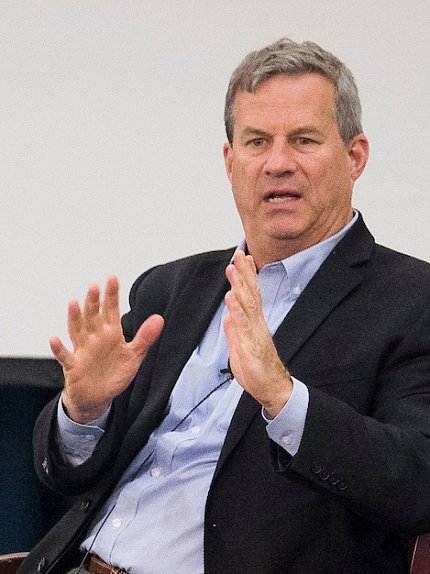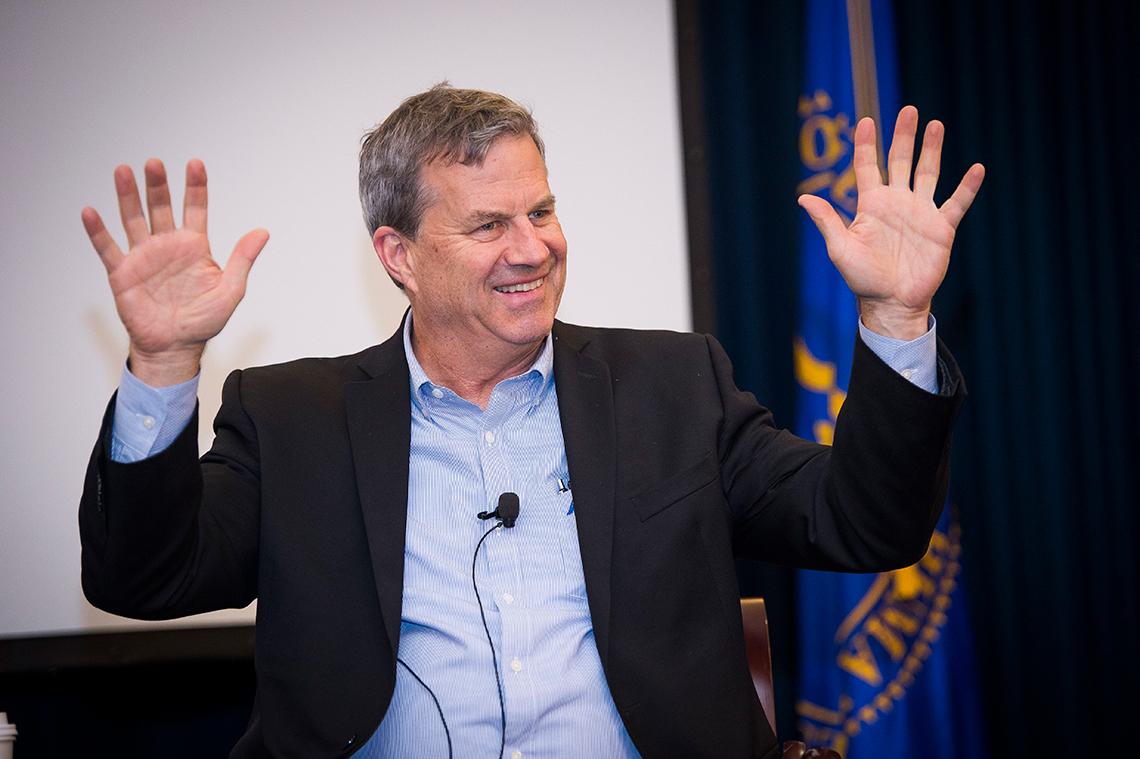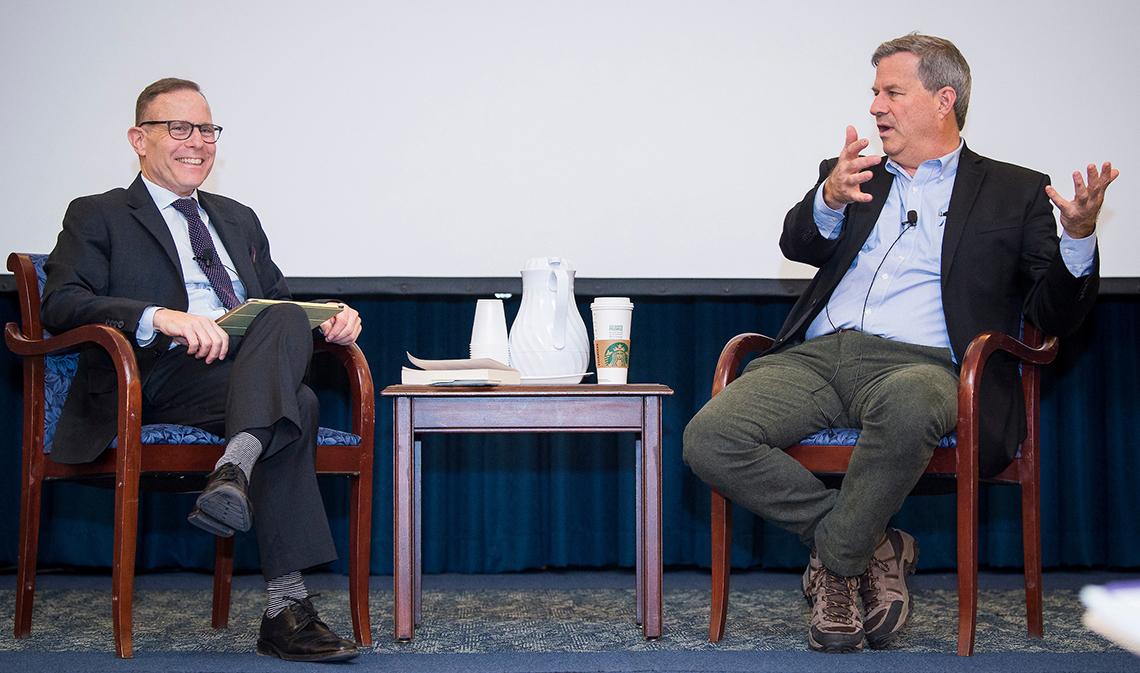Author Recounts How Opioids Took Hold in America

Photo: Lisa Helfert
In 2012, Sam Quinones, a crime reporter for the Los Angeles Times, almost couldn’t find a publisher for his book on the opioid epidemic. Overdoses were ravaging communities across America. Yet this addiction to opioids—from prescription painkillers to heroin—that has killed tens of thousands of Americans had long eluded the public’s radar.
At first, Quinones couldn’t find people to interview. No one wanted to talk.
“One guy told me that all across this country there are thousands and thousands of families, parents going to bed every night crying themselves to sleep, their arms around a photo album,” said Quinones, author of Dreamland: The True Tale of America’s Opiate Epidemic, who spoke at a recent NIDA event in Wilson Hall. “The worst fear they have is people finding out why their loved ones really died. There was a silence.”
Quinones, whose presentation took the form of a conversation with Dr. Jack Stein, director of NIDA’s Office of Science Policy and Communications, said people were fabricating relatives’ obituaries. They were ashamed and didn’t want exposure. “If you don’t have families on board, the media isn’t paying much attention...and politicians aren’t really in tune with it,” he said.
But eventually people began breaking their silence. “People gained encouragement from each other a little bit and began to realize they were not alone.”
Once There Was a Dreamland
When Quinones started writing Dreamland, he admittedly knew nothing about addiction or pain management, but he’d been reporting extensively on Mexican drug trafficking. Why, he wondered, are Mexican heroin traffickers doing such big business in America?
As Quinones discussed his research, coincidentally, NIH director Dr. Francis Collins was launching the administration’s opioid initiative in Ohio, the state where this story unfolds.
Dreamland was a huge community pool in Portsmouth, Ohio. Generations of families regularly hung out there; it was the soul of this bustling town. But in the 1980s, economic hardship set in; factories closed and half the population left. Dreamland had been “this essential thing that kept people in a community,” said Quinones. In 1993, it closed.
“Dreamland became a metaphor for America,” he said. “Nobody goes outside [anymore]. Everyone becomes cloistered indoors.”

Photo: Lisa Helfert
Gateway to a Crisis
As the economy declined, doctors in Portsmouth were dispensing oxycodone and other prescription painkillers like candy, without warning of possible addiction. As people got hooked and couldn’t get more or enough, they started turning to heroin, an opiate derivative, for their fix.
“The problem starts with very potent legal drugs,” Quinones said. “If you unleash a powerful new legal supply of drugs on the population, the consequences will be pretty scary and certainly unpredictable.”
A decade ago, Quinones first heard stories of people in Huntington, W.Va., switching from pain pills to a type of potent, cheap heroin and dying in large numbers. He started investigating how this black-tar heroin, which is only made in Mexico in this hemisphere, arrived in lethal quantities in a state east of the Mississippi where few Mexicans lived.
Quinones learned that, in the small town of Xalisco, Mexico, drug traffickers developed a refined system to sell black-tar heroin across the United States. He likened it to a pizza delivery service: convenient, regular delivery to satisfy the cravings of addicts, who had a customer service number they could call to order more. Quinones began to unravel the pain connection and discovered that the problem was endemic, from Rust Belt states to rich suburbs.
Prescription painkillers were cheap, available and initially underused, said Quinones. Some published research suggested narcotics were nonaddictive in supervised amounts, and the problem spiraled from there. “Patients were demanding to be fixed,” he said. “The easy answer is pills for everybody in large amounts over a long period of time.”
The opioid crisis grew from over-prescription and excess availability of legal opioids in this country. “Demand doesn’t come from Mafia or street peddlers,” he said. “It comes from doctors being pressured and pushed...they unleash collectively a supply of pain pills on this country that’s astounding and continues to be; prescribing is dropping, but it’s still outrageously high.”
In January, Quinones testified about the opioid crisis before the Senate. “It was the most surreal moment of my life,” he said. “I’m a crime reporter; I don’t function well in the halls of power. I prefer to talk to folks in prison.”

Photo: Lisa Helfert
For his book, Quinones interviewed imprisoned traffickers, addicts and their families, prosecutors, drug enforcement agents, pain specialists, doctors and rehab counselors. To lure readers, he structured the book like a compelling television series such as The Wire or Breaking Bad, he said, treating each short chapter like a scene.
There are multiple themes, but they all circle back to the sense of community that existed at Dreamland. “It was not just pharmaceutical marketing, not just Mexican trafficking,” said Quinones. “It was our own increasing isolation and the crushing destruction of entities that’d really brought us together as Americans. This became easily the main theme of the book.”
Toward a Solution: More Cuddling?
A group of neonatal nurses in a New Hampshire hospital once told Quinones that drug-addicted newborns need, above all, cuddling.
“Those little babies are showing us the fundamentals of this whole problem,” he said. “They’re all alone; they don’t want to feel alone, so you have cuddlers rocking them to sleep.” Addicts need a variety of services, but they also need to feel part of a community.
“We have a way forward,” he said, “working against that very pernicious, corrosive tendency toward isolation in our culture.”
Quinones advocates expanding addiction research across the Ohio Valley and involving more recovering addicts in research. Many are eager to help solve the problem, he said.
“Heroin is scary as hell. It’s a national catastrophe,” said Quinones, “but there’s also within it the seeds of enormous opportunity and rebirth.” To dig out of the opioid crisis will require massive grants and loans, he said, on par with the Marshall Plan that helped rebuild postwar Europe.
Anyone can get involved in helping end the isolation that breeds addiction. Join a community task force, for example, recommended Quinones. Our personal consumer decisions also matter.
“It’s incumbent on all of us,” he said, “to be accountable for our own wellness and, therefore, when we are [well], whatever decisions the pharmaceutical companies want to make about what to market to us will have far less importance and power.”
